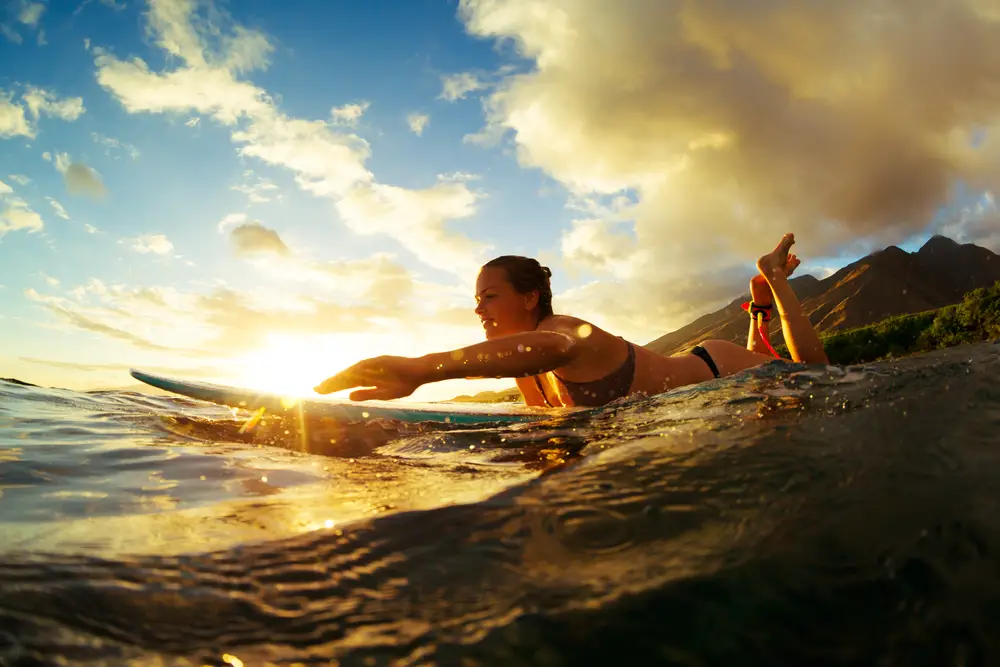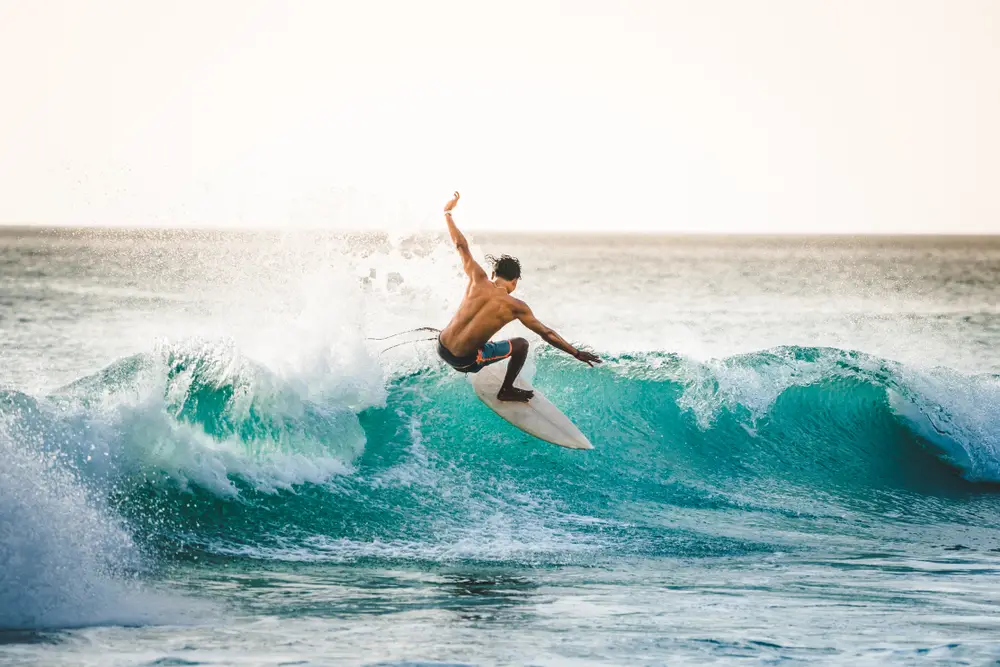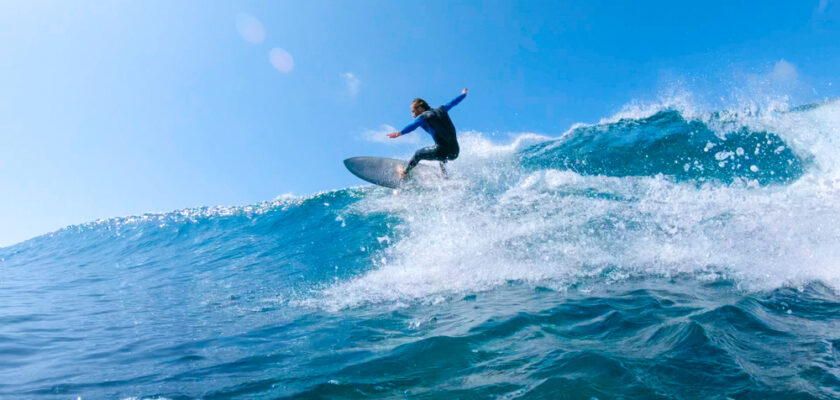Board, peak, swell, offshore and many other terms are part of the glossary of surfing. Find out more about each one and get a better understanding of the sport.
Surfing is a sport that combines skill, physical strength and, of course, a connection with the waves. Practiced in all maritime parts of the world, surfing has several themes that help describe the maneuvers, sea conditions and equipment used;
These terms are essential for anyone who wants to understand the sport better, whether as a practitioner or an enthusiast. That’s why we’ve created the glossary of surfingsurfing with the main words that describe the sport and now also the Olympic sport!
Check out the main terms in the surfing glossary!
Open your Betano account and get up to 1,000 reais in bonuses.
Payments via PIX, live games and super odds!
Click here to open your account!

Surf glossary: complete list
- Aerial
- Jellyfish
- Backdoor
- Nozzle
- Bottom Turn
- Fall
- Canal
- Cutback
- Cutback
- Drop
- Drop Knee
- Duck Dive
- Foam
- Floater
- Bottom
- Goofy
- Hang Ten
- Inside
- Line-up
- Lip
- Longboard
- Marola
- Offshore
- Ripple
- Peak
- Board
- Keel
- Regular
- Corkscrew
- Tube
Surf glossary: learn more about the terms
Aerial
This is a maneuver in which the surfer launches himself off the wave, flying through the air before landing back in the water. This technique requires control and skill and is one of the most spectacular maneuvers in the sport.
Jellyfish
The term used to describe a surfing session in very calm sea conditions, with no usable waves.
Backdoor
Backdoor is the act of entering the wave from the back of the peak, usually to surf a tube. It’s an advanced and challenging maneuver, especially on big, tubular waves.
Beak
This is the front part of the surfboard, also known as the “nose” in English. Good control of the nose is essential for good maneuvering.
Bottom Turn
This is one of the most important basic maneuvers in surfing, performed at the base of the wave to gain speed and positioning. It consists of turning the board in the desired direction as soon as the wave goes down.
Drop
A drop is the term used to describe a surfing session. For example, “I’m going down” means the phrase “I’m going surfing”.
Channel
The trough is the area of the sea where the waves don’t break, allowing surfers to paddle back to the peak with less resistance. Channels are formed by variations in the topography of the seabed.
Ride
The ride is the maneuver in which the surfer quickly rides down the face of the wave to gain speed and then perform another maneuver. It is essential for connecting movements and maintaining the flow of the wave.
Cutback
The maneuver in which the surfer makes an arc-shaped turn back towards the foam of the wave is called a cutback, and is essential for controlling speed and repositioning on the wave.
Drop
Dropping is the action of going down the face of the wave right after the initial paddle to catch it. A successful drop is essential for starting any maneuver on the wave.
Drop Knee
This is the style of surfing in which the surfer places one knee on the board, a technique associated with the longboard. It allows for greater control and style in the maneuvers.
Duck Dive
Duck diving is a technique used to pass under breaking waves while paddling towards the peak. It consists of sinking your board and body to avoid the impact of the wave.
Foam
Foam is the white part of the wave formed after it breaks, also called “marola”. Surfers often practice maneuvers in the foam to train and gain control.
Floater
This is the maneuver in which the surfer slides over the crest of the breaking wave. It requires balance and precision and is a technique for maintaining speed and controlling position on the wave.
Bottom
This is the type of underwater surface where the waves break. It can be sand, rock or coral and directly influences the shape and strength of the waves.
Goofy
Goofy is the style of surfing with the right foot in front of the board, the opposite of the “regular” style, where the left foot is in front.
Hang Ten
The hang ten is a classic longboard maneuver in which the surfer places all ten toes on the nose of the board. It requires balance and is a demonstration of skill.
Inside
Inside is the area closest to the beach where the waves have usually already broken. It can also refer to the place where surfers wait for smaller, easier-to-catch waves.
Line-up
This is the area in the sea where surfers wait for the waves, usually marked by a specific point where the waves begin to form. It’s basically the starting point for catching waves.
Lip
The lip is the top part of the wave that protrudes forward before it breaks. Many maneuvers, such as the slam or the floater, involve interactions with the lip.
Longboard
A longboard is a longer type of board. It’s ideal for smaller waves and classic maneuvers like the hang ten.
Marola
Marola is another word used for foam or small waves. Often used to describe easier, calmer surfing conditions.
Offshore
Offshore is the wind condition that blows from inland towards the sea, keeping the waves better formed and providing better surfing conditions.
Swell
The movement of waves generated by distant winds, which influences the formation and quality of the waves that reach the coast. Bigger swells usually bring bigger and more powerful waves.
Peak
A peak is the specific point where the waves begin to break, forming the main area where surfers wait to catch the waves. A good peak is essential for a successful surf session.
Surfboard
The surfboard is a surfer’s essential piece of equipment, available in various sizes and shapes for different styles and wave conditions. Choosing the right board is crucial for a good surfing performance.
Keel
Part attached to the underside of the board that helps stabilize and control direction. Boards can have one or several fins, which influences the style of surfing.
Regular
Style of surfing with the left foot in front of the board, as opposed to the “goofy” style, where the right foot is in front.
Corkscrew
Term for a wipeout or disastrous fall, where the surfer is thrown violently by the wave, often rolling like a corkscrew.
Tube
Tubing is one of the most desired maneuvers in surfing, in which the surfer enters the hollow part of the breaking wave, being enveloped by the water. Surfers constantly seek to catch tubes, as it is an exciting experience and a demonstration of skill and experience.

Surf glossary: complete list
- Aerial
- Jellyfish
- Backdoor
- Nozzle
- Bottom Turn
- Fall
- Canal
- Cutback
- Cutback
- Drop
- Drop Knee
- Duck Dive
- Foam
- Floater
- Bottom
- Goofy
- Hang Ten
- Inside
- Line-up
- Lip
- Longboard
- Marola
- Offshore
- Ripple
- Peak
- Board
- Keel
- Regular
- Corkscrew
- Tube
Surf glossary
That was the surfing glossary! Now that you know the main terms of the sport and have learned more about it, take the opportunity to continue exploring the site and learn much more about the sporting universe. Your comments are also very welcome here!



